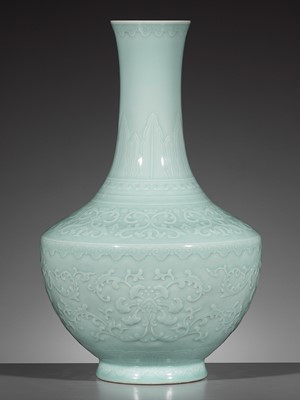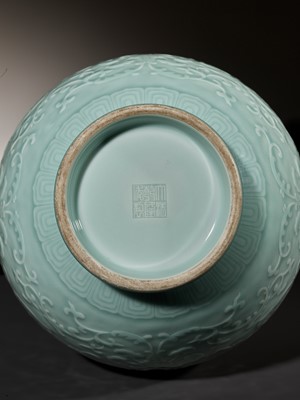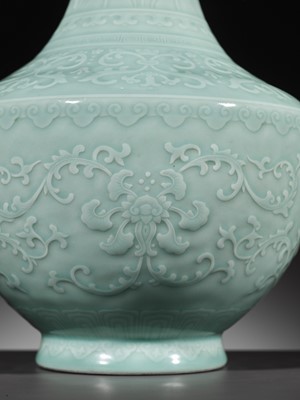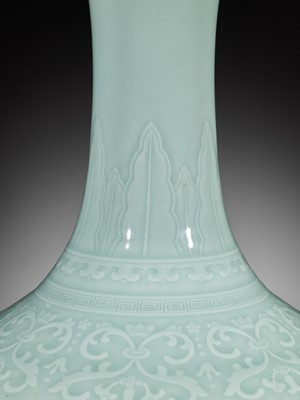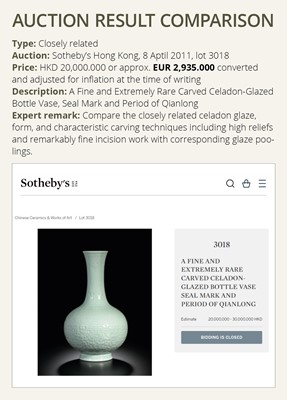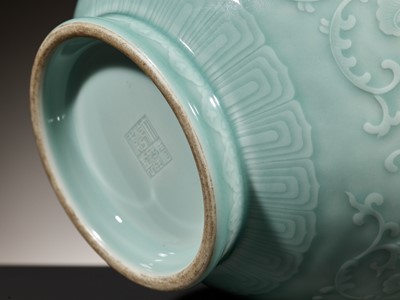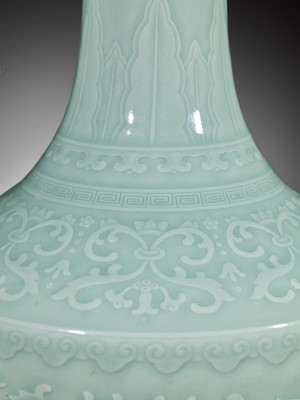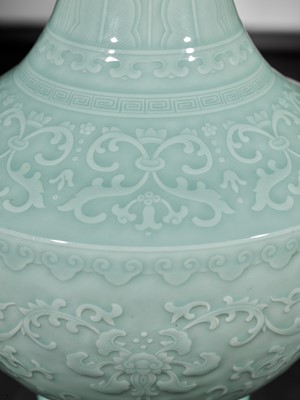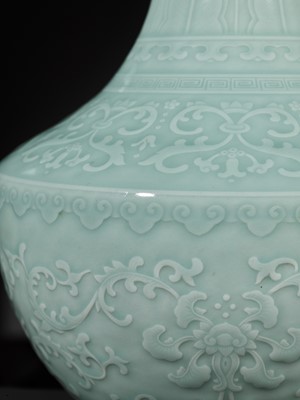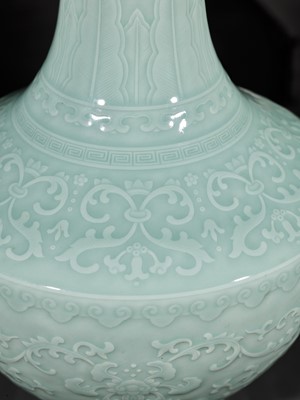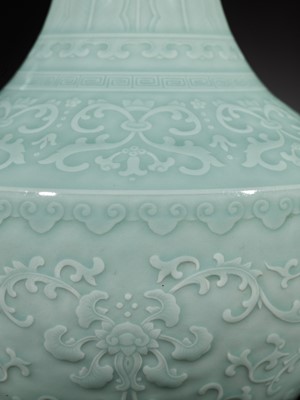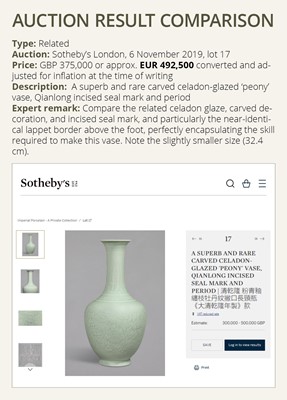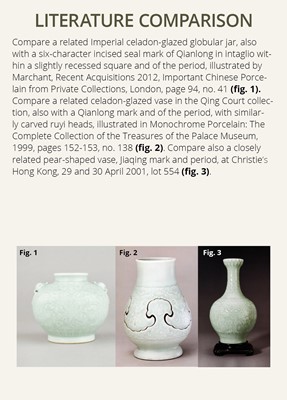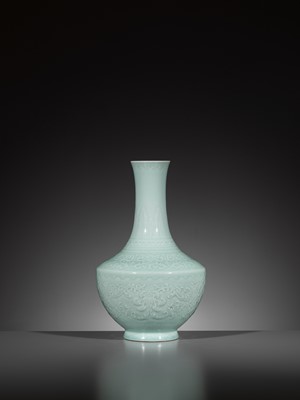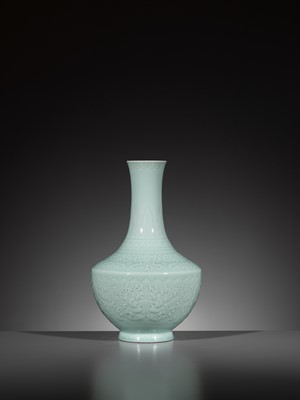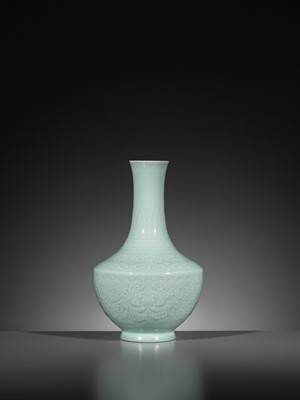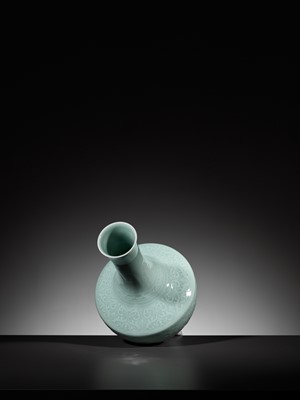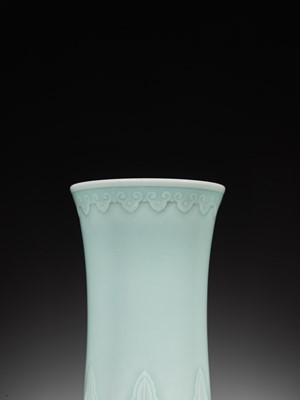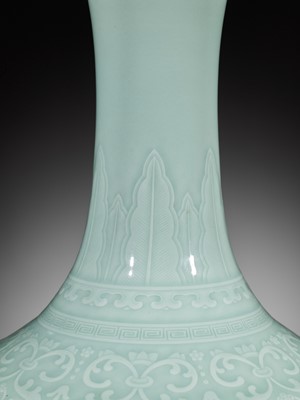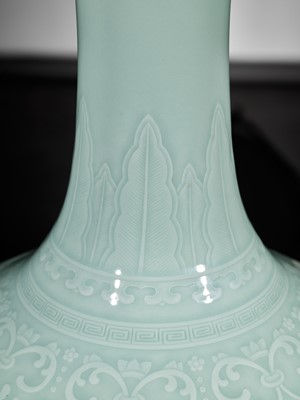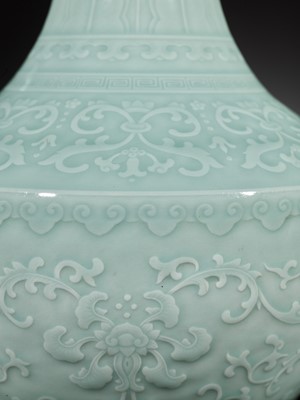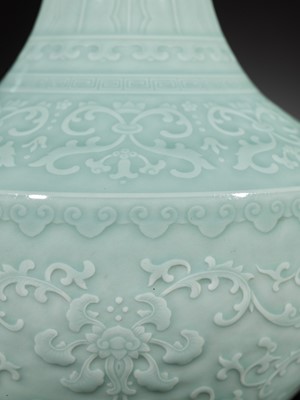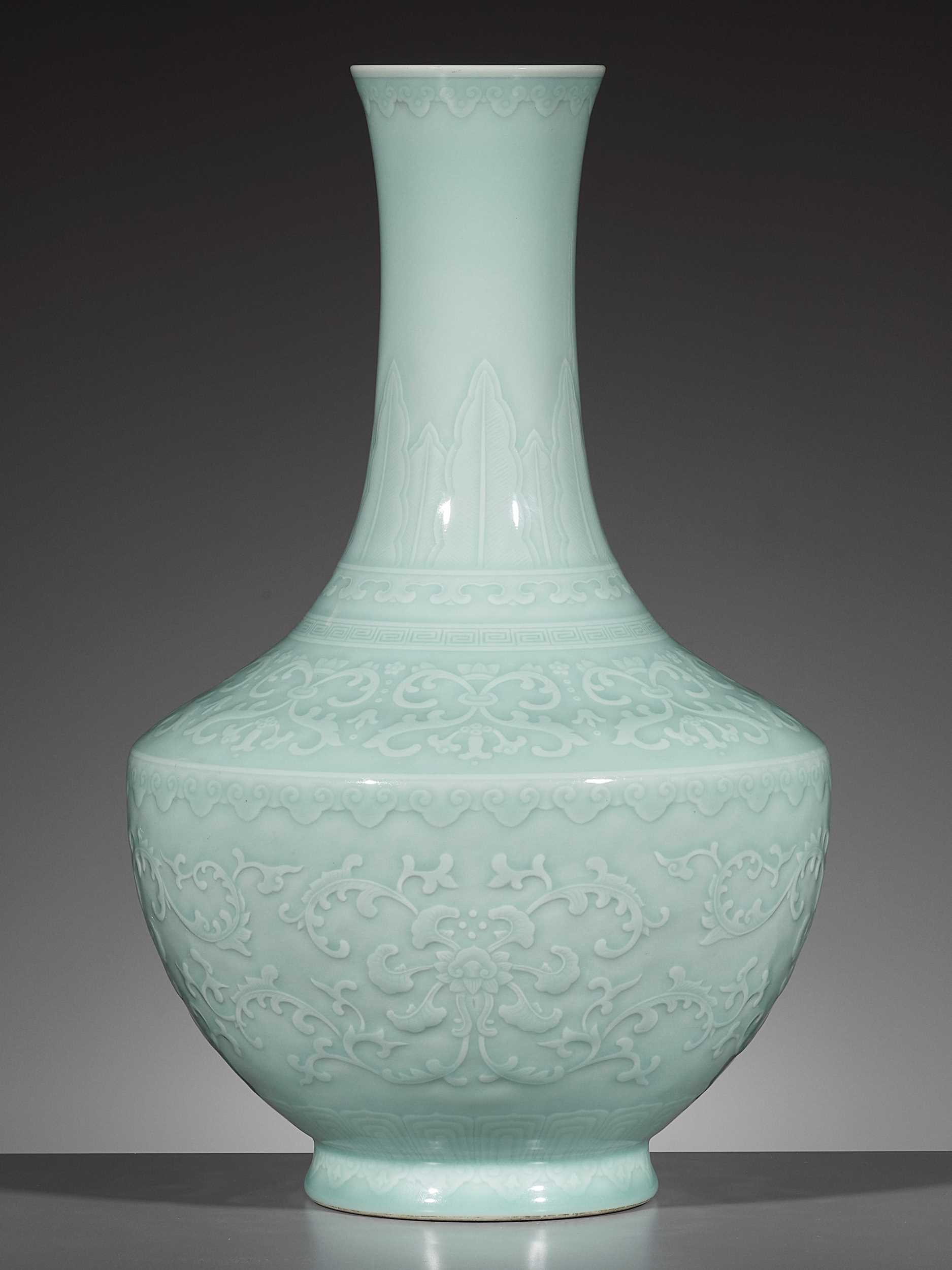10th Dec, 2022 11:00
Asian Art Holiday Sale
75
A CARVED CELADON-GLAZED ‘LOTUS’ VASE, QIANLONG MARK AND PERIOD
乾隆款及年代青釉暗刻纏枝蓮紋瓶
Sold for €169,000
including Buyer's Premium
China, 1736-1795. Finely carved in high relief around the body with stylized lotus flowerheads borne on scrolling leafy vines, overall incised with minute details, above a lappet border and below a band of ruyi heads. The shoulder similarly decorated with foliate scroll below a distinct leiwen border, the neck with overlapping palm blades above pendent trefoils, with further ruyi bands at the foot and below the rim. The base incised with a six-character seal mark da Qing Qianlong nianzhi in intaglio within a slightly recessed square and of the period.
Provenance: West Berkshire, United Kingdom, local trade. By repute acquired from a private estate.
Condition: Excellent condition with minor old wear and firing flaws, tiny surface scratches.
Weight: 3,097 g
Dimensions: Height 38.3 cm
The rounded sides supported on a spreading foot and sweeping up to an angular shoulder and waisted neck. Covered overall in a lustrous sea-green glaze pooling to a rich and deep celadon tone within the carved recesses. The base and inside glazed as well, leaving only the foot rim unglazed, revealing the white biscuit.
From its fine potting, translucent pale green celadon glaze, crisp lotus scroll and supporting designs, this vase reveals the technical and artistic virtuosity of craftsmen active at the Imperial kilns in Jingdezhen during the 18th century. The form evokes a sense of effortless elegance, despite its design being meticulously executed and conceived in advance. The decoration and glaze both draw from the celebrated ceramic tradition of Longquan in Zhejiang province and reinterpret it to suit the eclectic taste of the 18th century and growing interest in timeless elegance, literally overarching millennia.
Celadon-glazed wares are perhaps the type of ceramics most intimately associated with China. Their origins can be traced back to the Bronze Age, and since then they continued to be popular throughout the Chinese empire. The brilliant bluish-celadon glazes created at the Longquan kilns had provided much inspiration to the potters of the Jingdezhen imperial kilns since the early Ming dynasty. By lessening the amount of iron in the glaze, the potters were able to create a cool and delicate celadon glaze that, when applied on a white porcelain body, resembled the translucency and texture of pale celadon jade. A wide range of exquisite celadon tones was created in the early Qing dynasty, as a result of the Yongzheng and Qianlong Emperors’ appreciation of Song dynasty porcelain. Much admired by contemporary connoisseurs was the douqing (bean-green), a bright sea-green color, and the present fenqing (soft green), a pale celadon-green glaze. When applied to finely carved pieces as on the present vase, the thinning and pooling of the glaze on the raised lines and the recesses create a delicate shaded effect, thus accentuating the crispness of the design.
The present vase belongs to a group of monochrome wares where, by using a multi-level carving technique, the craftsmen have created a contrast in the color tone, as if two shades of the same color were used. The motif is elaborate and complex, displaying a level of porcelain carving and incision quality only achieved in the Imperial kilns of the 18th century, yet without any cluttering or overload whatsoever. The elegant silhouette of this vase, its restrained decoration, subtle glaze, and intaglio mark suggest that it was made in the early to middle years of the Qianlong reign, some time before designs slowly started to become overtly elaborate.
Expert’s note: The luxuriant lotus scroll on the present vase, which is particularly crisp in its rendering, was adapted from the somewhat rough and rustic designs on Longquan celadons of the Yuan and Ming dynasties. By adding tall palm blades to the neck, precise ruyi borders to the edges, multi-layer lappets to the lower body, and a hyper-accurate leiwen band to the shoulder, the artist has sensibly transitioned original Longquan designs into the highly formal décor language of the Imperial court. Later copies of these designs always lack such sophisticated semantics, for they not only demand complete submission to simplicity, but also scrupulously precise execution.
Literature comparison: Compare a related Imperial celadon-glazed globular jar, also with a six-character incised seal mark of Qianlong in intaglio within a slightly recessed square and of the period, illustrated by Marchant, Recent Acquisitions 2012, Important Chinese Porcelain from Private Collections, London, page 94, no. 41. Compare a related celadon-glazed vase in the Qing Court collection, also with a Qianlong mark and of the period, with similarly carved ruyi heads, illustrated in Monochrome Porcelain: The Complete Collection of the Treasures of the Palace Museum, 1999, pages 152-153, no. 138. Compare a related celadon-glazed vase with carved lotus scrolls, with a similar incised Qianlong seal mark and of the period, illustrated in Shanghai Museum, Beijing Museum, Art Museum, The Chinese University of Hong Kong, Qing Imperial Monochromes. The Zande Lou Collection, Shanghai, Beijing, Hong Kong, 2005, p. 120, no. 43. Compare a closely related celadon-glazed bottle vase, 37.5 cm high, also with a Qianlong mark and of the period, with similarly carved palm blades, at Sotheby’s Hong Kong, 8 April 2011, lot 3018. Compare a related celadon-glazed fanghu, 34.9 cm high, also with a Qianlong mark and of the period, with similarly carved lotus scroll, at Sotheby’s New York, 16 September 2014, lot 158. Finally, compare also a closely related pear-shaped vase, Jiaqing mark and period, at Christie's Hong Kong, 29 and 30 April 2001, lot 554.
Auction result comparison:
Type: Closely related
Auction: Sotheby’s Hong Kong, 8 April 2011, lot 3018
Price: HKD 20,000.000 or approx. EUR 2,935.000 converted and adjusted for inflation at the time of writing
Description: A Fine and Extremely Rare Carved Celadon-Glazed Bottle Vase, Seal Mark and Period of Qianlong
Expert remark: Compare the closely related celadon glaze, form, and characteristic carving techniques including high reliefs and remarkably fine incision work with corresponding glaze poolings.
Auction result comparison:
Type: Related
Auction: Sotheby’s London, 6 November 2019, lot 17
Price: GBP 375,000 or approx. EUR 492,500 converted and adjusted for inflation at the time of writing
Description: A superb and rare carved celadon-glazed ‘peony’ vase, Qianlong incised seal mark and period
Expert remark: Compare the related celadon glaze, carved decoration, and incised seal mark, and particularly the near-identical lappet border above the foot, perfectly encapsulating the skill required to make this vase. Note the slightly smaller size (32.4 cm).
乾隆款及年代青釉暗刻纏枝蓮紋瓶
中國,1736-1795年。侈口,長頸,折肩,鼓腹,圈足外撇。瓶身通體高浮雕,頸部芭蕉紋,口部和肩部分別飾如意紋帶、雷紋帶與卷草紋帶。腹部飾纏枝蓮紋。圈足内六字篆書款“大清乾隆年製”。通體施青釉,圈足底未上釉,露白色坯。
來源:英國伯克郡西部,當地古玩交易,據説購於一個私人收藏。
品相:狀況良好,有輕微磨損和燒製缺陷,表面有微小的劃痕。
重量:3,097 克
尺寸:高38.3 厘米
此瓶製作精美,淡綠色青釉清亮,線條優美的纏枝蓮紋,展現了十八世紀景德鎮御窯厰工匠的精湛技藝和藝術品味。瓶型優雅,紋飾和釉色取材於浙江省著名的龍泉陶瓷傳統,並對其進行了新的詮釋,以適應十八世紀不拘一格的品味,以及對永恆優雅的日益濃厚的興趣。
青釉瓷可能是中國文化藝術中最經典的陶瓷類型。它們的起源可以追溯到青銅器時代。自明初以來,龍泉窯的青釉瓷為景德鎮御窯的陶藝家們提供了許多靈感。通過減少釉中的鐵含量,陶工能夠創造出一種清麗細膩的青釉,生坯掛釉,更顯得匀净淡雅。清代初期,由於雍正、乾隆兩帝對宋瓷的推崇,產生了各式各樣精美的青色釉,如豆青和現在的粉青。
此瓶屬於單色釉器,通過浮雕暗紋,凸紋和凹紋上的釉料的變薄和匯集產生了微妙的陰影效果,彷彿使用了深淺不同的青色。紋飾精巧繁複,呈現出十八世紀御窯所獨有的精湛工藝。此瓶造型雅緻,紋飾內斂,釉色細膩,暗刻紋飾,意味著其製作時間為乾隆中期。
專家注釋:此瓶上的纏枝蓮紋畫法尤為明快,取材自元明龍泉青瓷略顯質樸的傳統紋樣。通過在頸部添加芭蕉紋,在邊緣有如意與雷紋紋飾帶,藝術家將龍泉窯紋飾轉變為御用紋飾。
文獻比較:比較一件相近的同時期御製青釉瓷罐,圈足内也有乾隆六字款,見Marchant, 《Recent Acquisitions 2012, Important Chinese Porcelain from Private Collections》,倫敦,頁94,編號41。比較一件相近的清廷藏乾隆款及年代青釉瓷瓶,也有相似的如意紋,見《故宫博物院藏文物珍品全集·顏色釉》,頁152-153,編號138。比較一件相近的乾隆款及年代纏枝蓮紋青釉瓷瓶,上海博物館、北京故宮博物院、香港中文大學文物館編,《暫得樓清代官窯單色釉瓷器》,上海、北京、香港,2005年,頁120,編號43。比較一件非常相近的乾隆款及年代青釉瓷瓶(高37.5 厘米),有相似的芭蕉紋,見香港蘇富比,2011年4月8日,lot 3018。比較一件相近的乾隆款及年代青釉瓷方壺(高34.9 厘米),見紐約蘇富比,2014年9月16日,lot 158。最後比較一件非常相近的嘉慶款及年代梨形瓶,見香港佳士得,2001年4月29-30日,lot 554。
拍賣結果比較:
形制:非常相近
拍賣:香港蘇富比,2011年4月8日, lot 3018
價格:HKD 20,000,000(相當於今日EUR 2,935,000)
描述:乾隆款及年代青釉瓷瓶
專家評論:比較非常相近的青釉、外型、相似的浮雕和暗刻雕刻技術。
拍賣結果比較:
形制:非常相近
拍賣:倫敦蘇富比,2019年11月6日,lot 17
價格:GBP 375,000(相當於今日EUR 492,500)
描述:清乾隆粉青釉纏枝牡丹紋撇口長頸瓶,《大清乾隆年製》款
專家評論:比較非常相近的青釉、雕刻裝飾、款識,特別是接近足部近乎相同的花邊,完美地概括了製作這個花瓶所需的精湛技術和它所散發的精緻的美。請注意尺寸較小 (32.4 厘米)。
China, 1736-1795. Finely carved in high relief around the body with stylized lotus flowerheads borne on scrolling leafy vines, overall incised with minute details, above a lappet border and below a band of ruyi heads. The shoulder similarly decorated with foliate scroll below a distinct leiwen border, the neck with overlapping palm blades above pendent trefoils, with further ruyi bands at the foot and below the rim. The base incised with a six-character seal mark da Qing Qianlong nianzhi in intaglio within a slightly recessed square and of the period.
Provenance: West Berkshire, United Kingdom, local trade. By repute acquired from a private estate.
Condition: Excellent condition with minor old wear and firing flaws, tiny surface scratches.
Weight: 3,097 g
Dimensions: Height 38.3 cm
The rounded sides supported on a spreading foot and sweeping up to an angular shoulder and waisted neck. Covered overall in a lustrous sea-green glaze pooling to a rich and deep celadon tone within the carved recesses. The base and inside glazed as well, leaving only the foot rim unglazed, revealing the white biscuit.
From its fine potting, translucent pale green celadon glaze, crisp lotus scroll and supporting designs, this vase reveals the technical and artistic virtuosity of craftsmen active at the Imperial kilns in Jingdezhen during the 18th century. The form evokes a sense of effortless elegance, despite its design being meticulously executed and conceived in advance. The decoration and glaze both draw from the celebrated ceramic tradition of Longquan in Zhejiang province and reinterpret it to suit the eclectic taste of the 18th century and growing interest in timeless elegance, literally overarching millennia.
Celadon-glazed wares are perhaps the type of ceramics most intimately associated with China. Their origins can be traced back to the Bronze Age, and since then they continued to be popular throughout the Chinese empire. The brilliant bluish-celadon glazes created at the Longquan kilns had provided much inspiration to the potters of the Jingdezhen imperial kilns since the early Ming dynasty. By lessening the amount of iron in the glaze, the potters were able to create a cool and delicate celadon glaze that, when applied on a white porcelain body, resembled the translucency and texture of pale celadon jade. A wide range of exquisite celadon tones was created in the early Qing dynasty, as a result of the Yongzheng and Qianlong Emperors’ appreciation of Song dynasty porcelain. Much admired by contemporary connoisseurs was the douqing (bean-green), a bright sea-green color, and the present fenqing (soft green), a pale celadon-green glaze. When applied to finely carved pieces as on the present vase, the thinning and pooling of the glaze on the raised lines and the recesses create a delicate shaded effect, thus accentuating the crispness of the design.
The present vase belongs to a group of monochrome wares where, by using a multi-level carving technique, the craftsmen have created a contrast in the color tone, as if two shades of the same color were used. The motif is elaborate and complex, displaying a level of porcelain carving and incision quality only achieved in the Imperial kilns of the 18th century, yet without any cluttering or overload whatsoever. The elegant silhouette of this vase, its restrained decoration, subtle glaze, and intaglio mark suggest that it was made in the early to middle years of the Qianlong reign, some time before designs slowly started to become overtly elaborate.
Expert’s note: The luxuriant lotus scroll on the present vase, which is particularly crisp in its rendering, was adapted from the somewhat rough and rustic designs on Longquan celadons of the Yuan and Ming dynasties. By adding tall palm blades to the neck, precise ruyi borders to the edges, multi-layer lappets to the lower body, and a hyper-accurate leiwen band to the shoulder, the artist has sensibly transitioned original Longquan designs into the highly formal décor language of the Imperial court. Later copies of these designs always lack such sophisticated semantics, for they not only demand complete submission to simplicity, but also scrupulously precise execution.
Literature comparison: Compare a related Imperial celadon-glazed globular jar, also with a six-character incised seal mark of Qianlong in intaglio within a slightly recessed square and of the period, illustrated by Marchant, Recent Acquisitions 2012, Important Chinese Porcelain from Private Collections, London, page 94, no. 41. Compare a related celadon-glazed vase in the Qing Court collection, also with a Qianlong mark and of the period, with similarly carved ruyi heads, illustrated in Monochrome Porcelain: The Complete Collection of the Treasures of the Palace Museum, 1999, pages 152-153, no. 138. Compare a related celadon-glazed vase with carved lotus scrolls, with a similar incised Qianlong seal mark and of the period, illustrated in Shanghai Museum, Beijing Museum, Art Museum, The Chinese University of Hong Kong, Qing Imperial Monochromes. The Zande Lou Collection, Shanghai, Beijing, Hong Kong, 2005, p. 120, no. 43. Compare a closely related celadon-glazed bottle vase, 37.5 cm high, also with a Qianlong mark and of the period, with similarly carved palm blades, at Sotheby’s Hong Kong, 8 April 2011, lot 3018. Compare a related celadon-glazed fanghu, 34.9 cm high, also with a Qianlong mark and of the period, with similarly carved lotus scroll, at Sotheby’s New York, 16 September 2014, lot 158. Finally, compare also a closely related pear-shaped vase, Jiaqing mark and period, at Christie's Hong Kong, 29 and 30 April 2001, lot 554.
Auction result comparison:
Type: Closely related
Auction: Sotheby’s Hong Kong, 8 April 2011, lot 3018
Price: HKD 20,000.000 or approx. EUR 2,935.000 converted and adjusted for inflation at the time of writing
Description: A Fine and Extremely Rare Carved Celadon-Glazed Bottle Vase, Seal Mark and Period of Qianlong
Expert remark: Compare the closely related celadon glaze, form, and characteristic carving techniques including high reliefs and remarkably fine incision work with corresponding glaze poolings.
Auction result comparison:
Type: Related
Auction: Sotheby’s London, 6 November 2019, lot 17
Price: GBP 375,000 or approx. EUR 492,500 converted and adjusted for inflation at the time of writing
Description: A superb and rare carved celadon-glazed ‘peony’ vase, Qianlong incised seal mark and period
Expert remark: Compare the related celadon glaze, carved decoration, and incised seal mark, and particularly the near-identical lappet border above the foot, perfectly encapsulating the skill required to make this vase. Note the slightly smaller size (32.4 cm).
乾隆款及年代青釉暗刻纏枝蓮紋瓶
中國,1736-1795年。侈口,長頸,折肩,鼓腹,圈足外撇。瓶身通體高浮雕,頸部芭蕉紋,口部和肩部分別飾如意紋帶、雷紋帶與卷草紋帶。腹部飾纏枝蓮紋。圈足内六字篆書款“大清乾隆年製”。通體施青釉,圈足底未上釉,露白色坯。
來源:英國伯克郡西部,當地古玩交易,據説購於一個私人收藏。
品相:狀況良好,有輕微磨損和燒製缺陷,表面有微小的劃痕。
重量:3,097 克
尺寸:高38.3 厘米
此瓶製作精美,淡綠色青釉清亮,線條優美的纏枝蓮紋,展現了十八世紀景德鎮御窯厰工匠的精湛技藝和藝術品味。瓶型優雅,紋飾和釉色取材於浙江省著名的龍泉陶瓷傳統,並對其進行了新的詮釋,以適應十八世紀不拘一格的品味,以及對永恆優雅的日益濃厚的興趣。
青釉瓷可能是中國文化藝術中最經典的陶瓷類型。它們的起源可以追溯到青銅器時代。自明初以來,龍泉窯的青釉瓷為景德鎮御窯的陶藝家們提供了許多靈感。通過減少釉中的鐵含量,陶工能夠創造出一種清麗細膩的青釉,生坯掛釉,更顯得匀净淡雅。清代初期,由於雍正、乾隆兩帝對宋瓷的推崇,產生了各式各樣精美的青色釉,如豆青和現在的粉青。
此瓶屬於單色釉器,通過浮雕暗紋,凸紋和凹紋上的釉料的變薄和匯集產生了微妙的陰影效果,彷彿使用了深淺不同的青色。紋飾精巧繁複,呈現出十八世紀御窯所獨有的精湛工藝。此瓶造型雅緻,紋飾內斂,釉色細膩,暗刻紋飾,意味著其製作時間為乾隆中期。
專家注釋:此瓶上的纏枝蓮紋畫法尤為明快,取材自元明龍泉青瓷略顯質樸的傳統紋樣。通過在頸部添加芭蕉紋,在邊緣有如意與雷紋紋飾帶,藝術家將龍泉窯紋飾轉變為御用紋飾。
文獻比較:比較一件相近的同時期御製青釉瓷罐,圈足内也有乾隆六字款,見Marchant, 《Recent Acquisitions 2012, Important Chinese Porcelain from Private Collections》,倫敦,頁94,編號41。比較一件相近的清廷藏乾隆款及年代青釉瓷瓶,也有相似的如意紋,見《故宫博物院藏文物珍品全集·顏色釉》,頁152-153,編號138。比較一件相近的乾隆款及年代纏枝蓮紋青釉瓷瓶,上海博物館、北京故宮博物院、香港中文大學文物館編,《暫得樓清代官窯單色釉瓷器》,上海、北京、香港,2005年,頁120,編號43。比較一件非常相近的乾隆款及年代青釉瓷瓶(高37.5 厘米),有相似的芭蕉紋,見香港蘇富比,2011年4月8日,lot 3018。比較一件相近的乾隆款及年代青釉瓷方壺(高34.9 厘米),見紐約蘇富比,2014年9月16日,lot 158。最後比較一件非常相近的嘉慶款及年代梨形瓶,見香港佳士得,2001年4月29-30日,lot 554。
拍賣結果比較:
形制:非常相近
拍賣:香港蘇富比,2011年4月8日, lot 3018
價格:HKD 20,000,000(相當於今日EUR 2,935,000)
描述:乾隆款及年代青釉瓷瓶
專家評論:比較非常相近的青釉、外型、相似的浮雕和暗刻雕刻技術。
拍賣結果比較:
形制:非常相近
拍賣:倫敦蘇富比,2019年11月6日,lot 17
價格:GBP 375,000(相當於今日EUR 492,500)
描述:清乾隆粉青釉纏枝牡丹紋撇口長頸瓶,《大清乾隆年製》款
專家評論:比較非常相近的青釉、雕刻裝飾、款識,特別是接近足部近乎相同的花邊,完美地概括了製作這個花瓶所需的精湛技術和它所散發的精緻的美。請注意尺寸較小 (32.4 厘米)。
Zacke Live Online Bidding
Our online bidding platform makes it easier than ever to bid in our auctions! When you bid through our website, you can take advantage of our premium buyer's terms without incurring any additional online bidding surcharges.
To bid live online, you'll need to create an online account. Once your account is created and your identity is verified, you can register to bid in an auction up to 12 hours before the auction begins.
Intended Spend and Bid Limits
When you register to bid in an online auction, you will need to share your intended maximum spending budget for the auction. We will then review your intended spend and set a bid limit for you. Once you have pre-registered for a live online auction, you can see your intended spend and bid limit by going to 'Account Settings' and clicking on 'Live Bidding Registrations'.
Your bid limit will be the maximum amount you can bid during the auction. Your bid limit is for the hammer price and is not affected by the buyer’s premium and VAT. For example, if you have a bid limit of €1,000 and place two winning bids for €300 and €200, then you will only be able to bid €500 for the rest of the auction. If you try to place a bid that is higher than €500, you will not be able to do so.
Online Absentee and Telephone Bids
You can now leave absentee and telephone bids on our website!
Absentee Bidding
Once you've created an account and your identity is verified, you can leave your absentee bid directly on the lot page. We will contact you when your bids have been confirmed.
Telephone Bidding
Once you've created an account and your identity is verified, you can leave telephone bids online. We will contact you when your bids have been confirmed.
Classic Absentee and Telephone Bidding Form
You can still submit absentee and telephone bids by email or fax if you prefer. Simply fill out the Absentee Bidding/Telephone bidding form and return it to us by email at office@zacke.at or by fax at +43 (1) 532 04 52 20. You can download the PDF from our Upcoming Auctions page.
How-To Guides
How to Create Your Personal Zacke Account
How to Register to Bid on Zacke Live
How to Leave Absentee Bids Online
How to Leave Telephone Bids Online
中文版本的操作指南
创建新账号
注册Zacke Live在线直播竞拍(免平台费)
缺席投标和电话投标
Third-Party Bidding
We partner with best-in-class third-party partners to make it easy for you to bid online in the channel of your choice. Please note that if you bid with one of our third-party online partners, then there will be a live bidding surcharge on top of your final purchase price. You can find all of our fees here. Here's a full list of our third-party partners:
- 51 Bid Live
- EpaiLive
- ArtFoxLive
- Invaluable
- LiveAuctioneers
- the-saleroom
- lot-tissimo
- Drouot
Please note that we place different auctions on different platforms. For example, in general, we only place Chinese art auctions on 51 Bid Live.
Bidding in Person
You must register to bid in person and will be assigned a paddle at the auction. Please contact us at office@zacke.at or +43 (1) 532 04 52 for the latest local health and safety guidelines.
